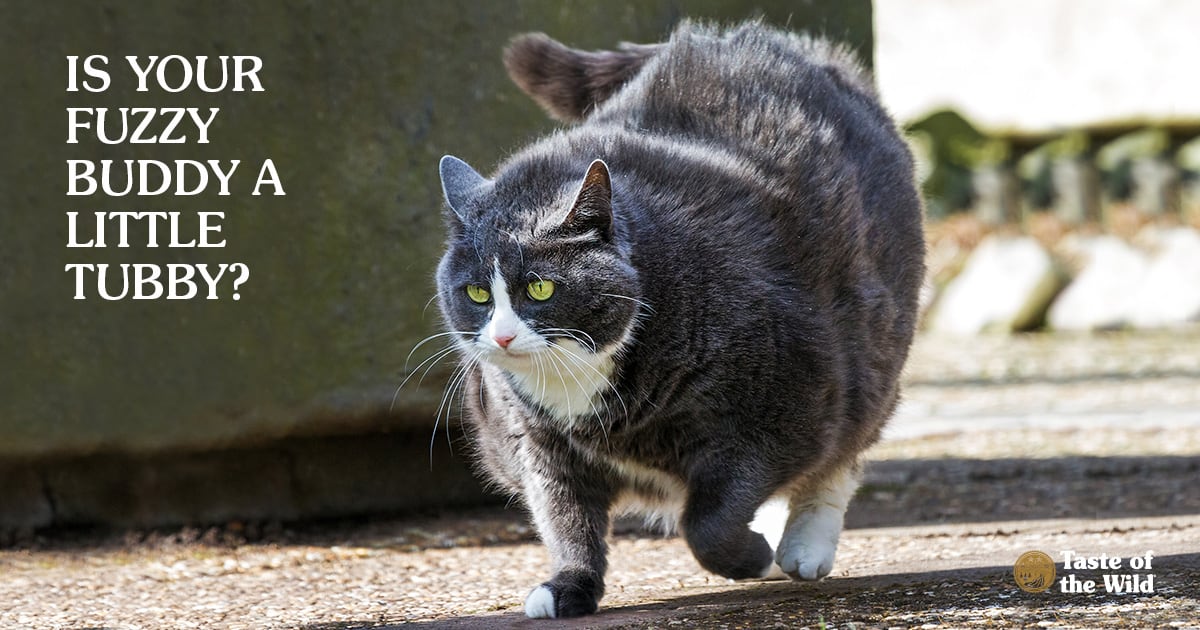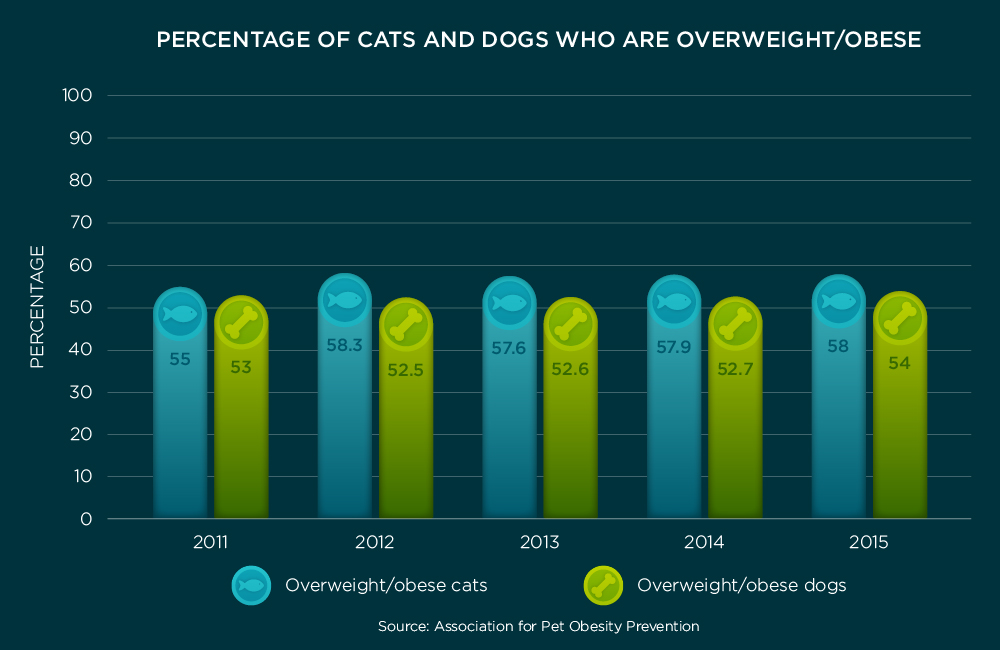
More than half of U.S. cats and dogs are overweight or obese, according to the Association for Pet Obesity Prevention (APOP), and the problem has gotten worse over the past three years. Just like people, overweight and obese pets face increased health risks, including:
- Arthritis
- Diabetes
- Decreased ability to exercise and increased risk of overheating
- Increased risk during anesthesia and surgery
- Shorter lifespan
So the most important decisions you’ll make today about your pet’s health are which pet food and how much of it you’ll feed.

Is your pet overweight or obese?
While surveys suggest pet owners may not recognize their dogs and cats as overweight, many owners still have some inkling about their pets’ size. So if you’re wondering whether your cat or dog is overweight or even obese, talk with your veterinarian.
You can quickly check whether your pet is becoming portly using the following approach:
- Does your pet have an easily identifiable “waist”? When you look down from above, do you see an hourglass shape with a waist behind the ribs? Does the abdomen slope upward from the ribs to the back legs when you look from the side? If your pup looks like a hot dog, chances are he or she is overweight.
- Can you easily feel your pet’s ribs? Run your hands along your pet’s side as if you’re petting him or her. If you can feel the ribs using only slight pressure, your pet is likely at an ideal weight. But if you need to apply pressure to feel the ribs, then your tabby is likely overweight or worse.
- Is your pet’s back flat? Can you see or feel “love handles” over the hips or top of the tail? Overweight or obese pets may look like they have a wider-than-normal back, and fat stores will be obvious.
If you think your pet is pudgy, you’ve taken an important first step toward addressing the problem. The next step is to schedule an appointment with your veterinarian, who can create a nutrition and exercise program to help your four-legged friend achieve their ideal weight and body condition.
Diet: The Cause and the Solution
Overweight and obese pets are a people problem, not a pet problem. That’s because many pet owners show affection by providing huge servings of food and treats. How much do you really feed your pet? As part of the nutrition planning process, your veterinarian may ask you to:
- Measure the amounts of food actually being fed
- Identify other sources of calories such as treats and table scraps
The results may surprise you. But armed with this information, your veterinarian can then make specific recommendations that typically cover:
- Realistic expectations. The 2014 American Animal Hospital Association Weight Management Guidelines for Dogs and Cats recommend a target weight loss of 1 percent to 2 percent of total body weight per week for dogs and 0.5 percent to 2 percent for cats.
- Appropriate dog or cat food. To achieve the desired weight loss yet still meet all nutritional needs, your pet may be transitioned to a different food.
- Specific amounts of food and treats. Measuring each serving, rather than simply filling the bowl, is critical to weight loss efforts. Table scraps should be completely eliminated from the pet’s diet and treats limited to no more than 10 percent of total daily calories. Instead of food treats, find other ways to shower your pet with attention and affection.
At least two meals should be fed daily; however, multiple small meals offered throughout the day is ideal, especially for cats.
- Activity and environmental enrichment. Just as with people, moderate exercise is part of pet weight-management programs. Regular activity helps reduce the muscle loss that occurs during weight loss and helps maintain or increase metabolism. Exercise recommendations should consider your pet’s current activity level and physical problems as well as your time constraints. Increases in activity and playtime should be gradual, starting with amounts the pet can comfortably handle.
- Weigh-ins to track progress and make adjustments. Taking photos during weight loss can help you see changes occurring in your pet. Regular, monthly weigh-ins at the veterinary clinic can help determine if the weight-loss approach is working. And if it isn’t, changes can be made.
RELATED: 7 Things to Know About Picky Eaters (And What to Do About It)
Put an End to the Upward Trend
The growing trend of overweight and obese pets can be reversed. However, it takes commitment and willingness to change: your perception of a healthy weight for your pet, how you feed your dog or cat, and what activities you and your pet participate in. The rewards — an improved quality and potentially increased quantity of life for your furry friend — are well worth the effort.
The information in this blog has been developed with our veterinarian and is designed to help educate pet parents. If you have questions or concerns about your pet's health or nutrition, please talk with your veterinarian.
